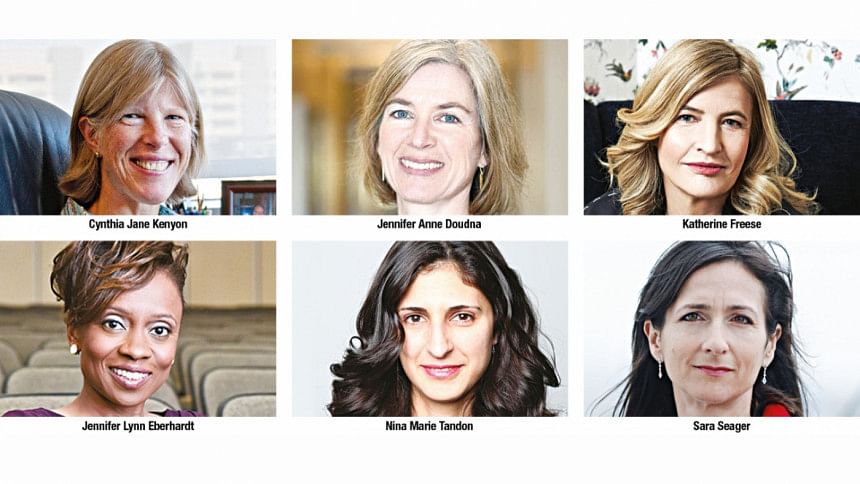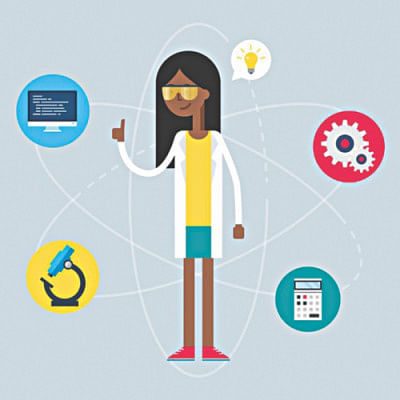women in STEM you need to know about

Throughout the ages, women have been substantially underrepresented in STEM (science, technology, engineering and math) fields. The reasons are many but they all point towards significant societal issue and stereotypical ideology. Even if blatant gender bias is somehow overcome, another factor, implicit bias or an unconscious set of beliefs still prevail to influence choices and assumptions of people. Despite the odds, women exist and thrive in these careers. Below is a list of inspiration, a list of genius women making huge strides in science and innovation.
Nina Marie Tandon, 39
Biomedical engineer and entrepreneur
Meet Nina, the CEO and co-founder of EpiBone, a bone reconstruction company. EpiBone aims to grow bones from a patient’s stem cells cancelling out complications of tissue rejection. Where it was once thought that bones could not be regrown, EpiBone continues to break barriers by culturing bones in precise, anatomical requirements. The bone tissue implanted is well alive and has the potential to grow and regenerate itself within the body. In 2011, she was named a TED Fellow and in the following year, a senior TED Fellow. That is no surprise because her work is revolutionising bone surgery and improving lives of an estimated 900,000 who go under the knife every year. She also holds 3 patents and has co-written a book called Super Cells: Building with Biology.
Sara Seager, 48
Astrophysicist and planetary scientist
Sara has got to find another earth, for real. In this process, she has discovered 715 exoplanets. An exoplanet is a planet orbiting a star other than the Sun or a planet outside of the Solar System. A new planet, earth’s counterpart could mean a lot of things given the global crisis of climate change and many other anthropogenic calamities. Back in 1994, when she started graduate school, exoplanets were not a thing yet and there was open skepticism regarding the idea. A whopping 4,000 exoplanets have been confirmed by NASA till date. And here is Sara contributing to about a fourth of the total. Amazing. In 2012, she has been listed under “25 Most Influential in Space” by Time Magazine. In the same year, she was a recipient of the Raymond and Beverly Sackler Prize in Physical Sciences followed by the prestigious MacArthur Fellowship in 2013.
Jennifer Lynn Eberhardt, 53
Social psychologist and professor
Jennifer studies the mechanism and effects of racism in our daily lives. Her findings are applied in the law-enforcement sector which helps improve the relationship between the police and the community. She is also a 2014 MacArthur winner. This year she has successfully published a book, Biased: Uncovering the Hidden Prejudice That Shapes What We See, Think, and Do. Eberhardt focuses on implicit bias. Her research shows how people connect black faces with crime subliminally and how this could corrupt the justice served. The matter of race first occurred to her at a tender age. As the youngest of five in the family, her intuitions only magnified when they moved to a white-dominant suburb.

Jennifer Anne Doudna, 55
Molecular biologist and professor
Ever heard of CRISPR? Yes, the “CRISPR” that took the world by storm last year when a Chinese scientist created the world’s first genetically edited babies using human embryos. In 2012, Jennifer, along with Emmanuelle Marie Charpentier were first to develop CRISPR-Cas9, a method of genetic engineering which enables precise genetic edits in the organism. This gene editing technology has the potential to cure tons of diseases like cystic fibrosis, HIV, sickle cell anemia and so on. The duo was awarded with the highly-acclaimed Breakthrough Prize in Life Sciences for their contributions later in 2015. She continues to advocate the safe use of this technology and to speak on the bioethics of changing an organism’s DNA.
Apart from CRISPR, Doudna has discovered the unusual mechanism by which hepatitis C virus synthesise viral proteins in cells. This finding can pave way to the production of new drugs to battle against the infection without harming the host’s tissue.
Katherine Freese, 62
Theoretical astrophysicist and professor
Katherine’s interests include dark energy, dark matter and inflation. The “dark” things have been tormenting physicists in this line for a long time. Dark energy makes up roughly 68% of the universe. Dark matter covers about 27%. And the rest is all that we see- the earth, the stars, the planets and everything else observed by existing instruments which is more or less 5%.
Freese has come to recognition for her theory on a new kind of star powered not by nuclear fuel but by dark matter. They are said to be “dark stars”. A part of her research constitutes how these strange stars can be observed. In 2012, she has been honored with the Simons Foundation Fellowship for her extraordinary work in Theoretical Physics. She is also the author of The Cosmic Cocktail: Three Part Dark Matter which gives a thorough insight on the workings and formation of the universe.
Cynthia Jane Kenyon, 65
Biogerontologist and geneticist
Cynthia is the vice president of Aging Research at Calico. She strives for a way to control aging and its related illnesses. Of all her work, she is well-known for altering a single gene in roundworms and doubling their lifespan in 1993. Since then she has discovered the rate of aging and mechanism in numerous species, many of which work via a universal hormone-signaling pathway. Kenyon’s research has caused her to make significant changes in her own diet such as switching to low-carbohydrate meals. In 2011, her efforts have earned her the Dan David Prize. The grant is presented by the Dan David Foundation that annually awards three prizes of $1 million each. She has many other honours under her belt such as the King Faisal Prize for Medicine, Ilse & Helmut Wachter Award for Exceptional Scientific Achievement, La Foundation IPSEN Prize and so on.
Hiya is currently drowning in deadlines. Reach her at [email protected]

 For all latest news, follow The Daily Star's Google News channel.
For all latest news, follow The Daily Star's Google News channel. 



Comments